Cat Food Puzzles: How and Why to Use Them
Cat food puzzles are a great form of both physical and mental stimulation. Of course, adventuring with your cat is too, but we all know it isn’t always possible to take your cat out. It might be too hot, too cold, or you might just be super busy with work or life.
That’s where these food puzzles for cats come in! They have multiple uses and purposes as well, which is awesome.
Interested in an ad-free experience?
Come join the Trailblazers community and get access to ALL KittyCatGO articles with ZERO ads!

*Disclosure: This post contains affiliate links. If you make a purchase using one of these links, I will receive a small commission at no extra cost to you. This helps me to continue creating helpful content. Don’t worry – I would never recommend something I don’t like or use myself!
What Are Cat Food Puzzles?
Cat food puzzles are basically exactly what they sound like. They are toys that hold cat food or treats and can be manipulated to release that food as your cat interacts with it. There are actually several different types of food puzzles for cats. Some are rolling, some are stationary, and you can even make your own DIY versions. Some require your cat to use their paws or nose to get the food, while others require your cat to use their tongue or jaw.
Stationary puzzles typically have cups, holes, or other obstacles that require your cat to use their paws to scoop out the food or to move pieces around to get the food. You can easily use both wet and dry food with these types of puzzles.
Mobile puzzle toys for cats are usually round and have holes of various sizes. To get the toy to dispense the food, your cat must roll or push it around. You can usually change the difficulty level of these types of toys by adjusting the hole sizes or quantities. Dry food or treats work best with these toys.
DIY puzzle toys are an option too. It’s not difficult to learn how to make toys for cats. You can use toilet paper or paper towel rolls, water bottles, egg cartons, muffin tins, tennis balls, small plastic containers, etc.
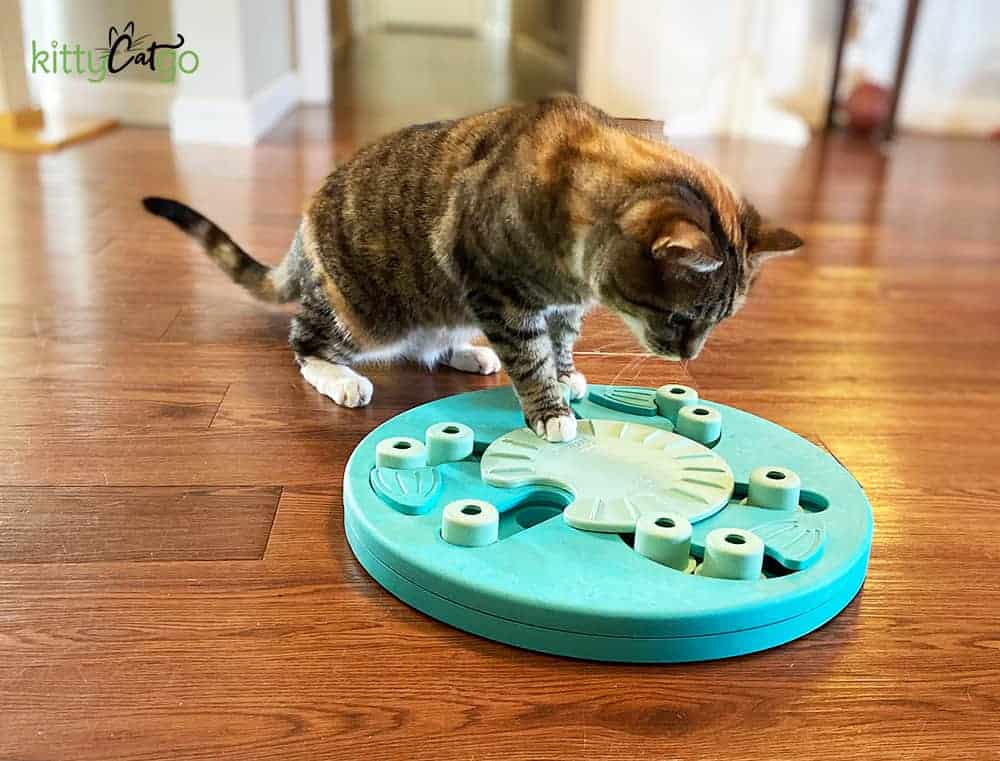
Why Should I Use Puzzle Toys for Cats?
As mentioned, using puzzle toys for cats is way to give your cat both mental and physical enrichment. Cats are predatory animals after all, so having to work for their food allows them to fulfill that hunting instinct. Puzzle feeders also increase their activity, reduce stress and boredom, and can even help them to lose weight. They help slow your cat’s eating down too, so if you have a “scarf and barfer,” feeding them with a puzzle feeder could be the solution!
Cat Behaviorist Ingrid Johnson says, “Cats need to be presented with something we call ‘positive frustration.’ When they are given this puzzle and then they figure it out, it’s very self-fulfilling because they’re getting what they want out of it. They’re getting food. It’s a good form of frustration that just challenges them a little bit.”
How to Use Cat Treat Puzzles
Cat treat puzzles can be used as a fun enrichment activity on any given day, but they can also be used as the primary means of feeding your cat. Some even use puzzles as the only means of feeding their cat.
As with anything new, you want to introduce these puzzles to your cat in a gradual manner, making it easy for them in the beginning. You don’t just want to start off by giving them the most difficult food puzzle possible.
It is suggested to start with a clear food puzzle rather than an opaque one. That way your cat can see there is food inside. You might even want to sprinkle a couple of treats or pieces of kibble on the floor beside the food puzzle to get them started.
The puzzle should also be almost just as easy as eating straight out of their bowl. Your cat shouldn’t have to work very hard at first. Fill the toy almost all the way up with treats or kibble, and make sure the puzzle can easily roll if it’s a mobile toy or that any cups are overflowing if it’s a stationary puzzle.
As your cat figures out how things work, you can begin to experiment with different types of puzzles and advance to more difficult ones.
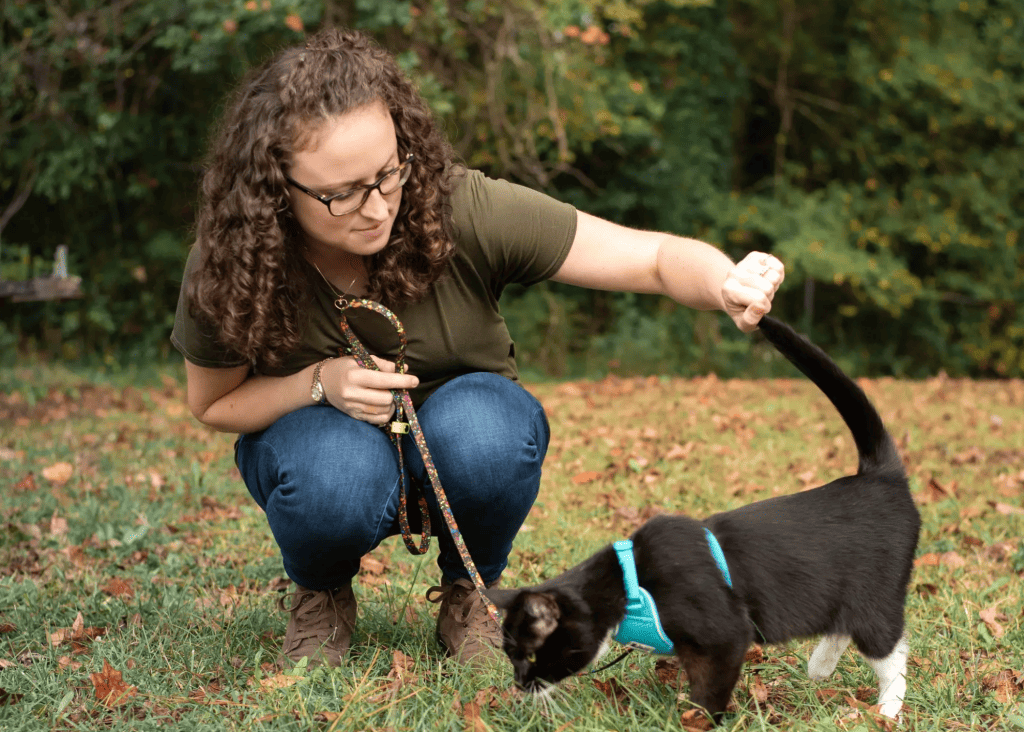
Is your cat meant for a life of adventure?
Let’s assess your cat’s personality to find out!
Tips for Making Your Cat Food Puzzles Harder
Cats do appreciate variety, so they may become bored with the same food puzzle day after day, especially as they become more adept at solving it. You can invest in new ones of course, but chances are you can use what you’ve got and alter it in some way to make it more difficult:
- Adjust openings to be smaller
- Tape up a couple holes
- Fill the toy with less food
- Layer your puzzles – for example, crumple up a piece of paper and put it inside your rolling food puzzle along with the kibble, creating an additional obstacle
- Drill holes in a small, square Tupperware container – it won’t roll as easily as a round rolling puzzle
- Hide the toys behind or under things so your cat has to sniff them out
Food Puzzle FAQs
Are there any puzzles that can be used with wet or raw food?
Yes! Many stationary cat food puzzles have little cup-type reservoirs that will work with wet or raw food as well as dry. Lickimats are great for feeding wet food as well.
What if I have multiple cats?
That’s okay! They can work together to solve the puzzles if they’d like.
If you’re using food puzzles as your primary means of feeding your cat rather than just a fun enrichment activity, be sure to provide your cats with multiple puzzle feeders – at least one for each cat. Use different types too, as each cat may have their own preference.
What if I have a dog?
Food puzzles are great for dogs too! However, if you don’t want your dog to get into your cat’s puzzle feeder, keep your dog out of the area where your cat’s puzzles are. You can use baby gates for this. Just be sure your cat can either jump over it or crawl under it.
What if my cat isn’t food motivated?
Try a different food or treat! Your cat might not be willing to work for the type of food they know they can get from their regular food bowl. Using a novel food – something new, something of high value – can help give your cat that extra motivation to work for it.
What if my cat isn’t interested in the puzzle?
It could be the type of food or treat you’re using (see answer to previous FAQ), or it could be that the puzzle is too difficult. Take things back a step or two, and try an easier puzzle.
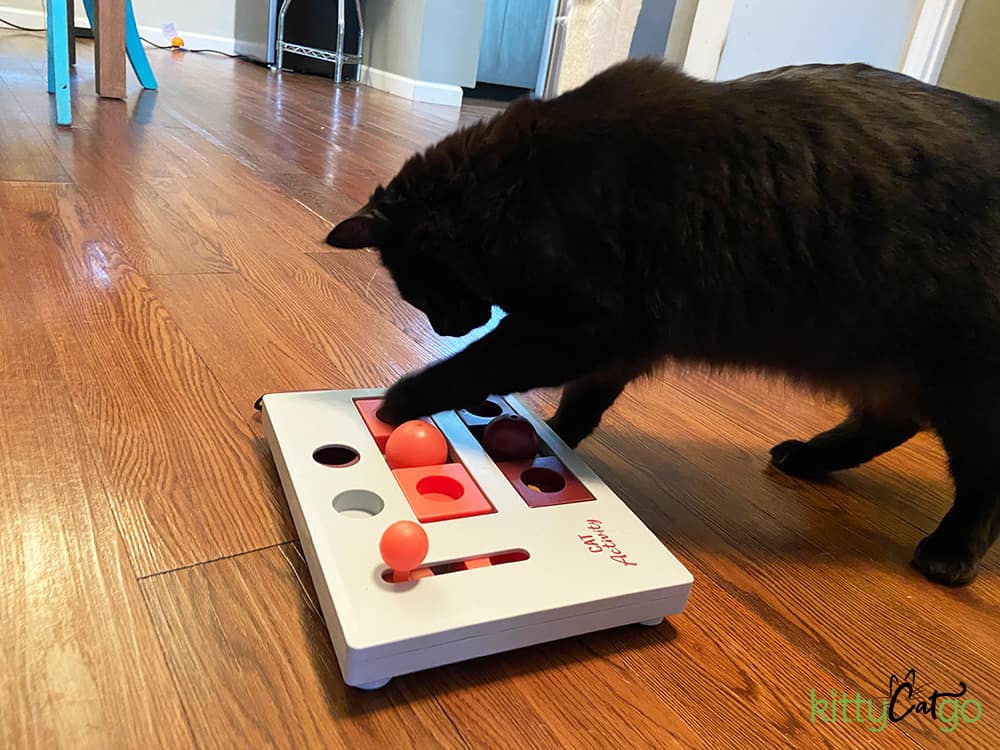
Our Favorite Food Puzzles for Cats
Best Food Puzzles for Beginners
- PetSafe SlimCat Feeder – this feeder is clear, has multiple adjustable holes, and easily rolls
- PetSafe Egg Cersizer Toy – this feeder is clear, has multiple adjustable holes, and easily rolls
- Foraging Ping Pong and Wiffle Balls by Fundamentally Feline – has multiple holes of varying sizes and easily rolls
- The Digger by Catit – a stationary puzzle that requires your cat to paw their food out of little containers
- Slow Feeder Bowls – a stationary feeder that requires your cat to paw their food out
Best Intermediate Food Puzzles
- Mousin’ Around by Petstages – requires your cat to bat them around to get the food out
- Foraging Gears by Fundamentally Feline – options for different sized holes. Notches keep the toy from easily rolling around. Can be stuffed with the foraging ping pong and wiffle balls for increased difficulty
- Melon Madness by Nina Ottosson – stationary puzzle that requires your cat to move pieces to uncover the food
- Trixie Activity Fun Board – a stationary puzzle that has multiple “surfaces” for your cat to forage food from
- The Cat Amazing – a stationary cardboard box with many compartments for your cat to forage from
Best Advanced Food Puzzles
- Brain Mover by Trixie Pet – has multiple components, including sliders, drawers, and cups
- Worker Puzzle by Nina Ottosson – a stationary feeder that requires your cat to move sliders and spin a wheel to get to the treats
- Catit Senses Food Maze – requires your cat to move food through multiple levels before the food dispenses
- Foraging Cubes by Fundamentally Feline – a cube with holes that dispense treats. It is quite difficult to get treats out of a cube, since it doesn’t roll.
- Buster Cube by OurPets – another cubed dispenser. Enough said.
Best Food Puzzles for Wet or Raw Food
- LickiMat – your cat has to lick the food off the different surfaces on the mat (Level: Easy)
- Doc & Phoebe’s Wet Feeder – a cup type feeder with rubber grooves to make it more difficult for your cat to lick the food out (Level: Easy)
- Trixie Activity Fun Board – has multiple “surfaces” for your cat to forage food from (Level: Intermediate)
- Melon Madness by Nina Ottosson – stationary puzzle that requires your cat to move pieces to uncover the food (Level: Intermediate)
- Brain Mover by Trixie Pet – has multiple components, including sliders, drawers, and cups (Level: Advanced)
Check out foodpuzzlesforcats.com for more reviews and suggestions!

Is your cat meant for a life of adventure?
Let’s assess your cat’s personality to find out!
KittyCatGO LIVE Season 2: Episode 1 – Hunting & Foraging
Check out this episode of KittyCatGO LIVE with Cat Behaviorist Ingrid Johnson for more tips on using food puzzles with your cats, including:
- why to use them
- how to use them
- advice on making them more difficult
- what to do if your cat won’t use them
- how to transition your cat from free-feeding to forage feeding
- puzzle recommendations

About the Author
Emily Hall, ABCCT is a certified cat trainer and cat adventure enthusiast. As a “mom” to five cats and one dog, she has been writing in the pet industry for over 10 years, with a focus on traveling and adventuring with cats.
Emily has a passion for getting out there and doing more with her cats – for pushing the bounds of cat expectations! She and her husband enjoy hiking, road-tripping, camping, and canoeing with their three cat adventurers. Read more about Emily here.

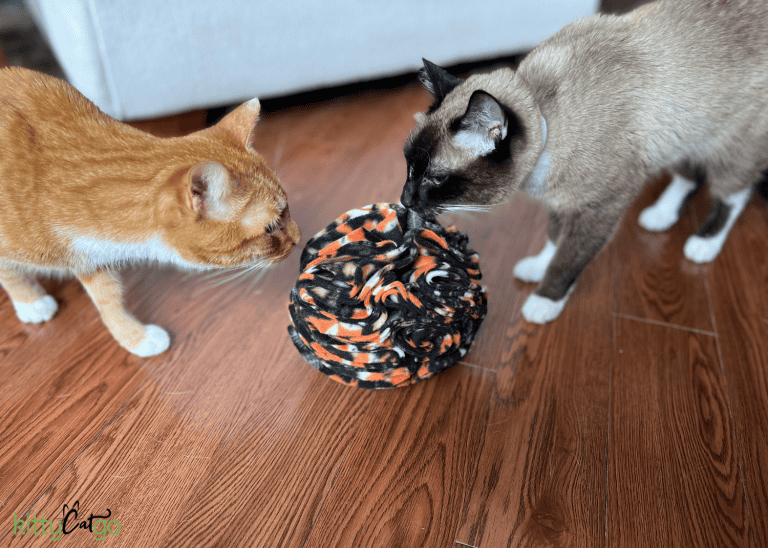
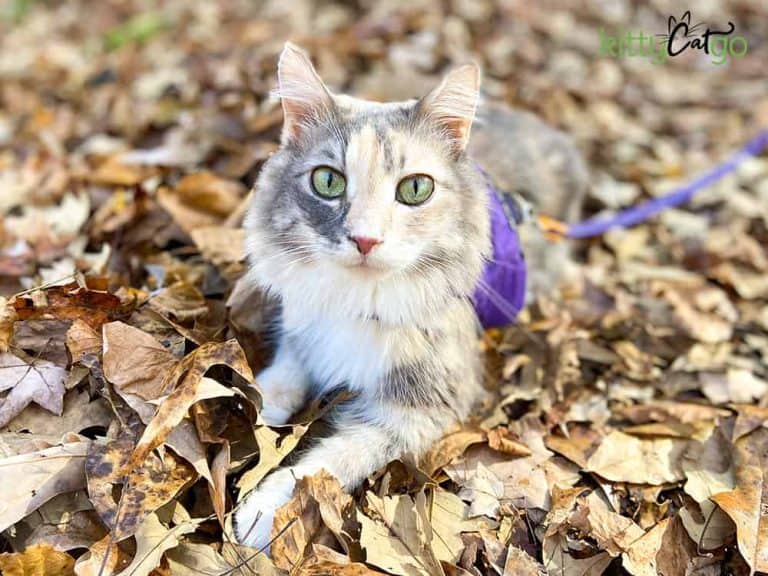
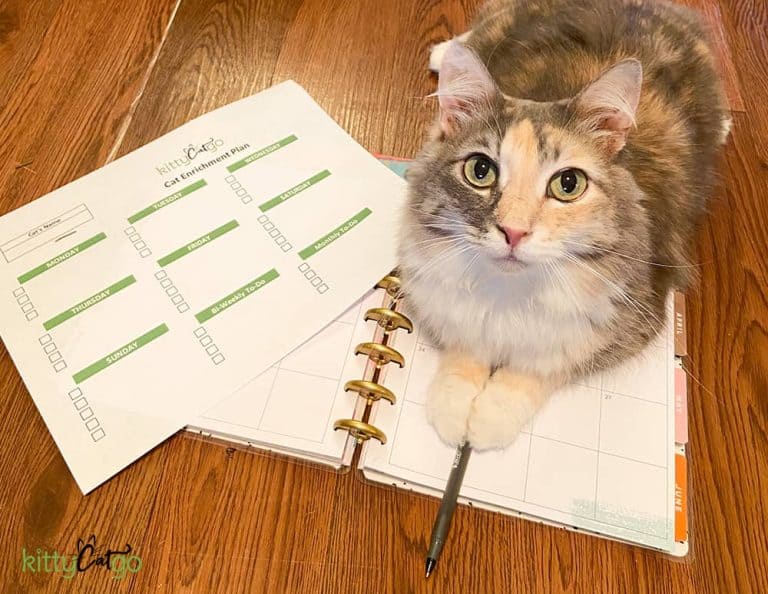
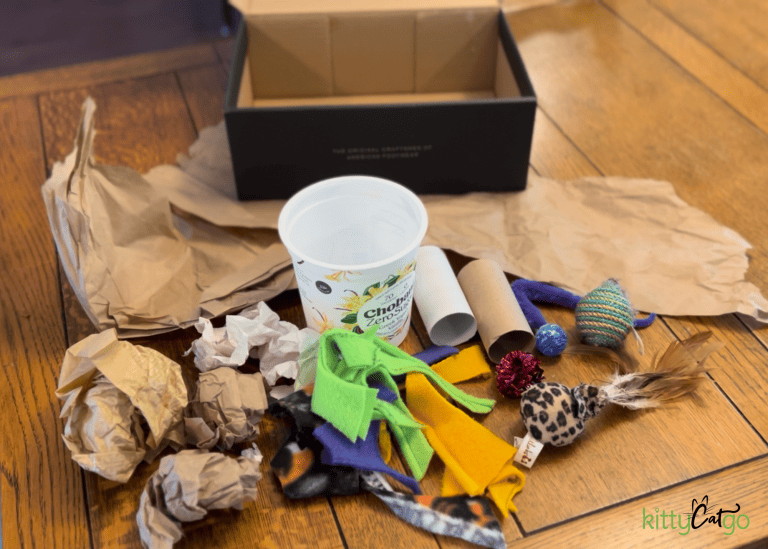
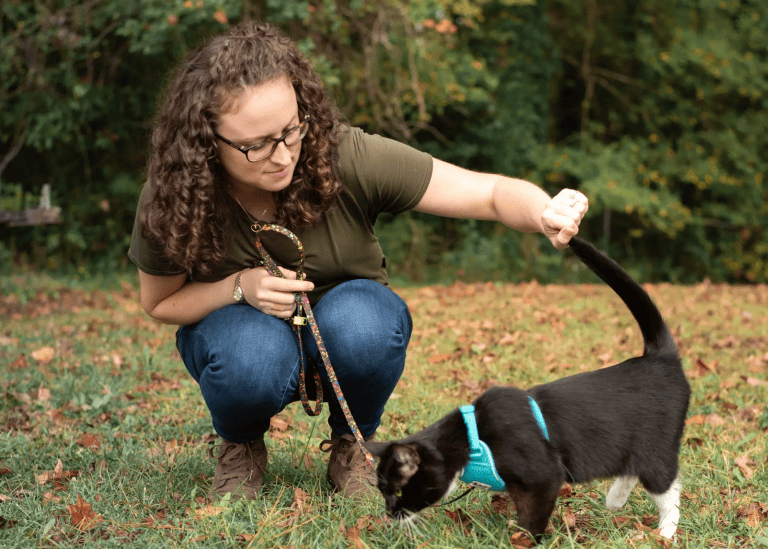
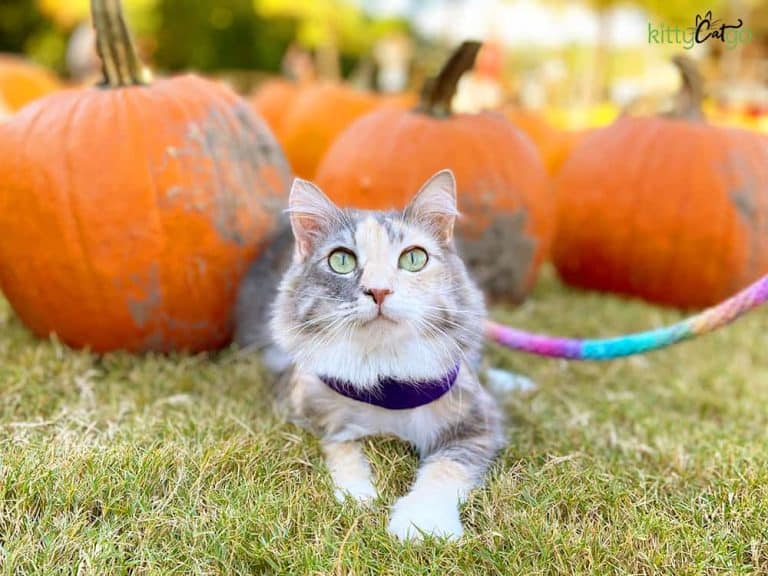
2 Comments